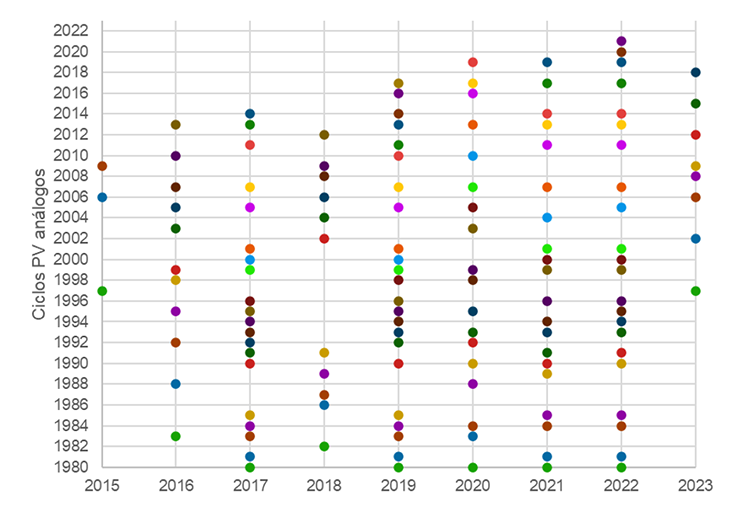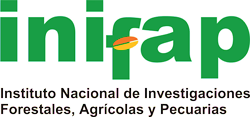Agricultural cycles analogous to ENSO: prediction of yields of rainfed corn and beans in Mexico
DOI:
https://doi.org/10.29312/remexca.v16i30.4053Keywords:
climate teleconnection, crop prediction, historical dataAbstract
The socioeconomic sector is increasingly relying on efficient and accessible tools to predict agri-environmental conditions. This study uses a decision tree classification model to identify agricultural cycles similar to the El Niño Southern Oscillation climate phenomenon. The objective is to historically relate the national agricultural yields of rainfed corn and beans in Mexico with ENSO, through the spring-summer (SS) agricultural censuses of 1980-2014, and to identify the spring-summer cycles analogous to the El Niño Southern Oscillation and subsequently simulate the yields of 2015-2023 (average of analogous years) for both crops. Additionally, the values of the simulations were adjusted using methods such as yield deviation and trend with the Mann-Kendall test of the previous cycle. The results of the mean absolute percentage error (MAPE) show a good fit for corn (MAPE= 4%) and beans (MAPE= 14%) with the use of deviations; the incorporation of the trend slightly improves the fit in beans (MAPE= 11%), but not in corn (MAPE= 22%). The effectiveness of these methods in forecasting yields months in advance depends mainly on the accuracy of El Niño Southern Oscillation temperature forecasts. This empirical method demonstrates potential to be applied in other rainfed crops and regions influenced by the El Niño Southern Oscillation; therefore, it offers a valuable tool for anticipating socioeconomic impacts related to this phenomenon.
Downloads
References
Acosta-Díaz, E.; Hernández-Torres, I.; Rodríguez-Guerra, R.; Pedroza-Flores, J.; Amador-Ramírez, M. D. y Padilla-Ramírez, J. S. 2011. Efecto de la sequía en la producción de biomasa y grano de frijol. Revista Mexicana de Ciencias Agrícolas. 2(2):249-263.
Beebe, S. E.; Rao, I. M.; Blair, M. W. and Acosta-Gallegos, J. A. 2013. Phenotyping common beans for adaptation to drought. Frontiers in Physiology. 4(35):1-20. https://doi.org/10.3389/fphys.2013.00035.
Blanco-Macías, F.; Magallanes-Quintanar, R.; Márquez-Madrid, M.; Cerano-Paredes, J.; Martínez-Salvador, M. and Valdez-Cepeda, R. D. 2020. Relationship between El Niño Southern Oscillation and Mexico’s orange yield anomalies. Terra Latinoamericana. 38(4):827-832. https://doi.org/10.28940/terra.v38i4.582.
Bojórquez-Serrano, J. I.; Vidal-Martínez, V. A.; Álvarez-Bravo, A. and Coutiño-Estrada, B. 2020. Influence of ‘El Niño, southern oscillation’ on the yield of rainfed corn in Nayarit. Revista Mexicana de Ciencias Agrícolas. 11(6):1413-1421. https://doi.org/10.29312/remexca.v11i6.2572.
Cao, J.; Zhang, Z.; Tao, F.; Chen, Y.; Luo, X.; and Xie, J. 2023. Forecasting global crop yields based on El Nino Southern Oscillation early signals. Agricultural Systems. 205-103564:1-12. https://doi.org/10.1016/j.agsy.2022.103564.
Conde, C.; Ferrer, R. and Orozco, S. 2006. Climate change and climate variability impacts on rainfed agricultural activities and possible adaptation measures. A Mexican case study. Atmósfera. 19(3):181-194.
FAO. 2017. Organización de las Naciones Unidas para la Alimentación y la Agricultura. El estado mundial de la agricultura y la alimentación: innovación para la agricultura familiar. 1-153 pp. http://www.fao.org/3/a-i7658s.pdf.
Flores-Gallardo, H.; Flores-Magdaleno, H.; Rubiños-Panta, J. E.; Prado-Hernández, J. V.; Meraz-Maldonado, N. y Ascencio-Hernández, R. 2024. Simulación del crecimiento y rendimiento de frijol cultivado bajo temporal con el modelo aquacrOP. Revista Fitotecnia Mexicana. 47(4):359-368. https://doi.org/10.35196/rfm.2024.4.359.
García-Montesinos, L. E.; Fernández-Reynoso, D. S.; Rubio-Granados, E.; Martínez-Menez, M. R. and Tijerina-Chávez, L. 2020. Maize (Zea mays L.) yields in Southern Mexico calculated by the decision support system for agrotechnology transfer. Terra Latinoamericana. 38(4):859-870. https://doi.org/10.28940/terra.v38i4.751.
González-González, M. A. and Guertin, D. P. 2021. Seasonal bean yield forecast for non-irrigated croplands through climate and vegetation index data: geospatial effects. International Journal of Applied Earth Observation and Geoinformation, 105:102623:1-12. https://doi.org/10.1016/j.jag.2021.102623.
González-González, M. A.; and Corrales-Suastegui, A. 2024. Monthly precipitation outlooks for Mexico using El Niño Southern Oscillation indices approach. Atmosphere, 15(8):981:1-14. https://doi.org/10.3390/atmos15080981.
Kucharik, C. J. and Serbin, S. P. 2008. Impacts of recent climate change on Wisconsin corn and soybean yield trends. Environ. Res. Lett. 3(3), 034003:1-10. Doi: 10.1088/1748-9326/3/3/034003.
Llanes-Cárdenas, O.; Norzagaray-Campos, M.; Gaxiola, A. and González, G. E. G. 2020. Regional precipitation teleconnected with PDO-AMO-ENSO in northern Mexico. Theoretical and Applied Climatology, 140(1):667-681. https://doi.org/10.1007/s00704-019-03003-7.
Muñoz, I. M.; Osorio, E. Y. R.; Herrera, J. S. A. y David, L. L. 2022. Ruta turístico-gastronómica entre México y Colombia basada en sus productos endémicos: maíz y frijol Iucma-Uaem. TURPADE. Turismo, Patrimonio y Desarrollo. 12(7):1-13.
Najafi, E.; Devineni, N.; Khanbilvardi, R. M.; and Kogan, F. 2018. Understanding the changes in global crop yields through changes in climate and technology. Earth’s Future, 6(3):410-427. https://doi.org/10.1002/2017EF000690.
Qian, Y.; Zhao, J.; Zheng, S.; Cao, Y. and Xue, L. 2020. Risk assessment of the global crop loss in ENSO events. Physics and Chemistry of the Earth, Parts A/B/C, 116(3),102845:1-10. https://doi.org/10.1016/j.pce.2020.102845.
Ramírez-Gil, J. G.; Henao-Rojas, J. C. and Morales-Osorio, J. G. 2020. Mitigation of the adverse effects of the El Niño (El Niño, La Niña) Southern Oscillation (ENSO) phenomenon and the most important diseases in avocado cv. Hass crops. Plants, 9(6):790:1-21. https://doi.org/10.3390/plants9060790.
Rezaei, E. E.; Webber, H.; Asseng, S.; Boote, K.; Durand, J. L.; Ewert, F. and MacCarthy, D. S. 2023. Climate change impacts crop yields. nature reviews earth and environment. 4(12):831-846. https://doi.org/10.1038/s43017-023-00491-0.
Reyes-González, F.; Galvis-Spinola, A.; Almaraz-Suárez, J. J. y Hernández-Mendoza, T. M. 2021. Modelo estadístico para la predicción del rendimiento de grano en maíz. Revista Mexicana de Ciencias Agrícolas. 12(3):447-459. https://doi.org/10.29312/remexca.v12i3.2482.
Sazib, N.; Mladenova, L. E.; and Bolten, J. D. 2020. Assessing the impact of ENSO on agriculture over Africa using earth observation data. Frontiers in Sustainable Food Systems. 4, 509914:1-11. Doi: 10.3389/fsufs.2020.509914.
Servín-Palestina, M.; Salazar-Moreno, R.; López-Cruz, I. L.; Medina-García, G. y Cid-Ríos, J. A. 2022. Predicción de la producción y rendimiento de frijol, con modelos de redes neuronales artificiales y datos climáticos. Biotecnia. 24(2):104-111. https://doi.org/10.18633/biotecnia.v24i2.1664.
Siebert, S.; Webber, H. and Rezaei, E. E. 2017. Weather impacts on crop yields-Searching for simple answers to a complex problem. Environ. Res. Lett. 12(8):1-3. https://doi.org/10.1088/1748-9326/aa7f15.
Velasco-Hernández, M. D. L. Á.; Morales-Acoltzi, T.; García-Castro, M. Á.; Bernal-morales, R.; Zagoya-Martínez, J.; Juárez-Sánchez, J. P. and Ramírez-Valverde, B. 2021. Effects of atlantic and Pacific Ocean teleconnections on corn yield east of Puebla, Mexico: case studies. International Journal of Environment and Climate Change. 11(1):85-99. Doi: 10.9734/IJECC/2021/v11i130346.
Yadav, K.; and Geli, H. M. 2021. Prediction of crop yield for New Mexico based on climate and remote sensing data for the 1920-2019 period. Land. 10(12):1389:1-27. https://doi.org/10.3390/land10121389.
Zhai, P.; Yu, R.; Guo, Y.; Li, Q.; Ren, X.; Wang, Y. and Ding, Y. 2016. The strong El Niño of 2015/16 and its dominant impacts on global and China's climate. Journal of Meteorological Research. 30:283-297. https://doi.org/10.1007/s13351-016-6101-3.
Zipper, S. C.; Qiu, J. and Kucharik, C. J. 2016. Drought effects on US maize and soybean production: spatiotemporal patterns and historical changes. Environ. Res. Lett. 11(9):094021:1-21. Doi: 10.1088/1748-9326/11/9/094021.

Published
How to Cite
Issue
Section
License
Copyright (c) 2025 Revista Mexicana de Ciencias Agrícolas

This work is licensed under a Creative Commons Attribution-NonCommercial 4.0 International License.
The authors who publish in Revista Mexicana de Ciencias Agrícolas accept the following conditions:
In accordance with copyright laws, Revista Mexicana de Ciencias Agrícolas recognizes and respects the authors’ moral right and ownership of property rights which will be transferred to the journal for dissemination in open access. Invariably, all the authors have to sign a letter of transfer of property rights and of originality of the article to Instituto Nacional de Investigaciones Forestales, Agrícolas y Pecuarias (INIFAP) [National Institute of Forestry, Agricultural and Livestock Research]. The author(s) must pay a fee for the reception of articles before proceeding to editorial review.
All the texts published by Revista Mexicana de Ciencias Agrícolas —with no exception— are distributed under a Creative Commons License Attribution-NonCommercial 4.0 International (CC BY-NC 4.0), which allows third parties to use the publication as long as the work’s authorship and its first publication in this journal are mentioned.
The author(s) can enter into independent and additional contractual agreements for the nonexclusive distribution of the version of the article published in Revista Mexicana de Ciencias Agrícolas (for example include it into an institutional repository or publish it in a book) as long as it is clearly and explicitly indicated that the work was published for the first time in Revista Mexicana de Ciencias Agrícolas.
For all the above, the authors shall send the Letter-transfer of Property Rights for the first publication duly filled in and signed by the author(s). This form must be sent as a PDF file to: revista_atm@yahoo.com.mx; cienciasagricola@inifap.gob.mx; remexca2017@gmail.
This work is licensed under a Creative Commons Attribution-Noncommercial 4.0 International license.


